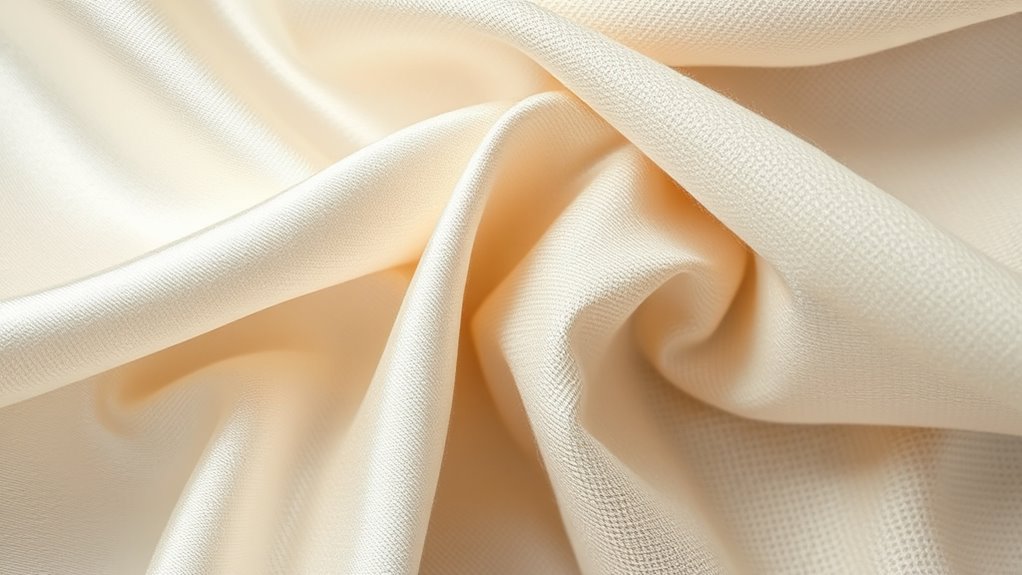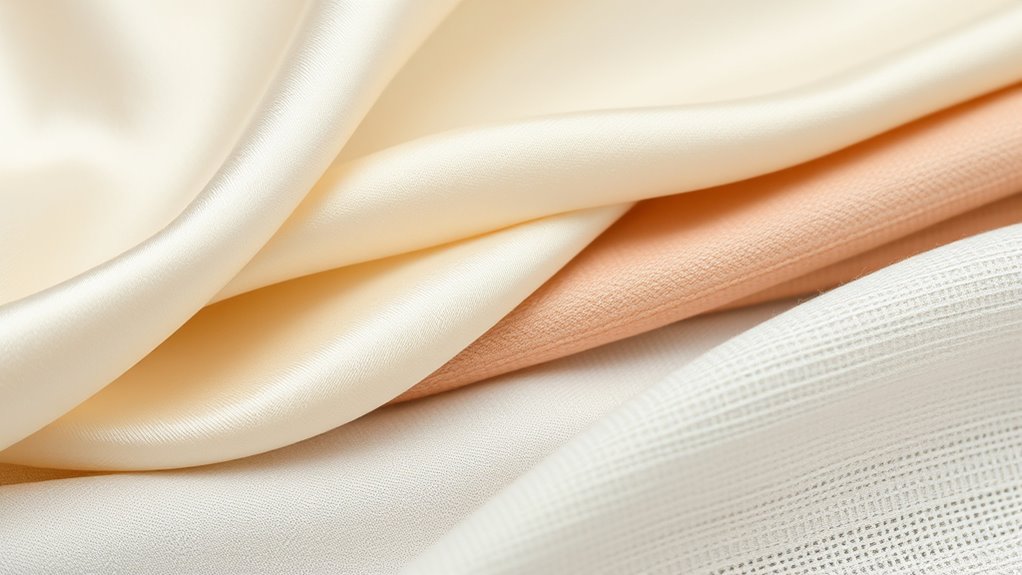Discover the secrets behind silk, cotton, and linen to make smarter choices for your wardrobe. Silk offers luxury but needs gentle care to keep its shine, while cotton is versatile and easy to maintain. Linen is durable, eco-friendly, and keeps you cool. By understanding their qualities and how to care for them sustainably, you can align your style with your values. Continue exploring to learn how to optimize your fabric knowledge even further.
Key Takeaways
- Silk, cotton, and linen each have unique characteristics influencing their care, durability, and environmental impact.
- Proper cleaning and maintenance extend fabric lifespan while reducing environmental harm.
- Sustainable sourcing and ethical production support eco-friendly practices and fair labor conditions.
- Choosing natural and eco-friendly detergents minimizes chemical pollution and promotes sustainability.
- Informed fabric choices reflect personal values, reduce ecological footprints, and support responsible fashion.

Have you ever wondered what your fabric really reveals about your clothing? The truth is, the materials you choose tell a story about your values, lifestyle, and even the environment. When you pick fabrics like silk, cotton, or linen, you’re not just selecting textures—you’re making decisions that impact the planet. Understanding fabric care and sustainable sourcing can help you make smarter choices, guaranteeing your wardrobe aligns with your commitment to sustainability.
Silk, often regarded as the luxury fabric, demands delicate care to maintain its natural sheen and softness. Proper fabric care involves gentle washing, preferably by hand or on a delicate cycle, using eco-friendly detergents. This not only prolongs the life of your silk pieces but also minimizes environmental impact. Sustainable sourcing is a crucial aspect here, as ethically produced silk is derived from silkworms raised under humane conditions, with minimal use of chemicals. By choosing silk that’s sustainably sourced, you support environmentally responsible practices and ensure that your clothing doesn’t contribute to harmful industry standards.
Cotton, a staple in most wardrobes, offers a versatile and breathable fabric that’s easy to care for but requires mindful selection. Organic cotton, grown without synthetic fertilizers or pesticides, exemplifies sustainable sourcing and reduces chemical runoff, promoting healthier ecosystems. When caring for cotton, you want to wash in cold water to save energy and extend fabric life. Avoiding harsh detergents and opting for natural or eco-friendly options preserves both the fabric’s integrity and the environment. Additionally, line drying instead of machine drying cuts down on energy use and prevents unnecessary wear. Your choices in caring for cotton can greatly influence the longevity of your garments and the sustainability of your wardrobe.
Linen, known for its durability and cooling properties, is another natural fiber that benefits from proper fabric care. Linen should be washed gently, preferably in cold or lukewarm water, to prevent shrinking and maintain its crisp texture. As linen is often produced from flax, a plant that requires fewer pesticides and fertilizers, choosing linen from sustainable sources supports eco-friendly farming practices. When you care for linen properly—ironing when damp and avoiding harsh chemicals—you help preserve its natural beauty and strength. By selecting linen that’s sustainably sourced, you’re endorsing agricultural methods that respect the environment and promote fair labor practices.
In essence, understanding fabric care and sustainable sourcing isn’t just about maintaining your clothes; it’s about making informed choices that support a healthier planet. Every fabric you wear carries a story—one of craftsmanship, environmental responsibility, and your personal values. When you pay attention to these details, your wardrobe becomes more than just a collection of clothes; it becomes a statement of your commitment to sustainable living.
Frequently Asked Questions
How Do I Identify Authentic Silk From Synthetic Alternatives?
To identify authentic silk from synthetic alternatives, focus on fiber authenticity and textile identification. Feel the fabric’s texture—real silk feels smooth, soft, and luxurious, while synthetic fibers often seem rough or plastic-like. Conduct a burn test: real silk burns slowly, smells like burning hair, and leaves a soft ash. Synthetic fibers melt, smell chemical, and form hard beads. These tests help you distinguish genuine silk from imitation fabrics effectively.
What Are the Best Ways to Care for Delicate Linen Fabrics?
Caring for delicate linen fabrics is almost like tending to a fragile treasure. You’ll want to avoid harsh detergents and opt for gentle washing, preferably by hand or on a delicate cycle. Once clean, store your linen properly—folded neatly in a cool, dry place. This way, your linen stays soft and beautiful, ready to impress without turning into a wrinkled relic of neglect.
Can Cotton Fabrics Be Naturally Dyed at Home?
Yes, you can naturally dye cotton fabrics at home using simple home dye techniques. Start by choosing plant-based dyes like indigo, turmeric, or onion skins. Prepare your dye bath by boiling the plant material, then soak your cotton in the dye until you achieve the desired color. Remember to mordant your fabric beforehand to enhance color fastness. Natural dyeing at home is eco-friendly and allows you to create unique, vibrant shades.
How Do Fabric Blends Affect the Longevity of Silk, Cotton, and Linen?
Like a fine tapestry, your fabric’s blend composition influences its longevity. When you combine silk, cotton, and linen, you create a unique fabric durability that depends on the blend ratio. A balanced blend enhances strength and wear resistance, while too much silk may reduce durability. Pay attention to the fabric composition, and you’ll enjoy longer-lasting garments that stand the test of time, much like legends etched in history.
Are There Eco-Friendly Options for Sustainable Silk Production?
You’ll find eco-friendly options for sustainable silk production through eco-friendly sericulture, which minimizes environmental impact by reducing water and chemical use. Sustainable dyeing practices also play a key role, using natural or low-impact dyes to lessen pollution. These methods help you enjoy beautiful silk while supporting eco-conscious choices, ensuring that your fashion choices contribute to a healthier planet without compromising quality or style.
Conclusion
Now that you’ve uncovered the secrets of silk, cotton, and linen, you’re equipped to make smarter fabric choices. Think of these materials as your wardrobe’s trusted allies, each with its own personality and charm. When you pick the right fabric for the right occasion, you’ll wear your knowledge like a badge of style and sophistication. So go ahead—dive into the world of fabrics and let your wardrobe tell a story as rich as the fibers themselves.









